Laser Absorption Sensing Systems: Challenges, Modeling, and Design Optimization
Abstract
1. Introduction
1.1. Overview of Laser Absorption Sensor Developments and Applications
1.2. Scope and Organization of the Paper
2. Sensor Design Targets and Measurement Challenges
3. Fundamentals of Different LAS Measurement Schemes
3.1. Direct Absorption Spectrocopy
3.2. 2f-WMS Method
3.3. Calibration-Free WMS-2f/1f Method
3.4. Recovery of the Absorbance Profile Based On Higher-Order Harmonic Signals
3.5. DAS-Calibrated WMS
3.6. Summary of Measurement Schemes
4. Strategies for Noise Reduction and Design Optimization
4.1. Souces of Noise
4.1.1. Laser and Detector Noise
4.1.2. Quantization Noise and ADC Resolution
4.1.3. Optical Interference Fringe Noise
4.2. Strategies Based On Laser Control Parameter Optimization
4.3. Strategies based On Signal Processing Schemes
4.3.1. Baseline Fitting for Blended Absorption Feature
4.3.2. In Situ Parameter Fitting
4.3.3. Harmonic Wavelet Analysis of Modulated TDLAS Signals
5. Conclusions and Future Outlook
Author Contributions
Funding
Conflicts of Interest
Nomenclature
| LAS | Laser absorption spectroscopy |
| DAS | Diode absorption spectroscopy |
| WMS | Wavelength modulation spectroscopy |
| TDLAS | Tunable diode laser absorption spectroscopy |
| LOS | Line-of-sight |
| SNR | Signal-to-noise ratio |
| It [W/cm2] | Transmitted light intensity |
| I0 [W/cm2] | Incident light intensity |
| αν | Absorbance |
| kν [1/cm] | Spectral absorption coefficient |
| L [cm] | Absorption pathlength |
| n [molecule/cm3] | Number density of the absorbing species |
| σν [cm2/molecule] | Absorption cross- section |
| S [cm−2/atm] | Absorption linestrength |
| ϕν [cm] | Frequency-dependent lineshape function |
| P [atm] | Pressure |
| Xi | Mole fraction of the absorbing species i |
| ν | Light frequency |
| NEA | Noise equivalent absorbance |
| DFBs | Distributed feedback lasers |
| VCSELs | Vertical-cavity surface-emitting lasers |
| FDML | Fourier-domain mode locked |
| QCLs | Quantum cascade lasers |
| ICLs | Interband cascade lasers |
| LM | Levenberg –Marquardt |
| AI | Advanced integrative |
| HITRAN | High Resolution Transmission |
| HITEMP | High Temperature |
| R2f | 2f peak ratio |
| T | Temperature |
| X0 | Nominal concentration |
| a | Modulation depth |
| i1, | 1st-order laser intensity modulation indices |
| i2 | 2nd-order laser intensity modulation indices |
| φ1 | 1st-order laser intensity–frequency modulation phase shifts |
| φ2 | 2nd-order laser intensity-frequency modulation phase shifts |
| ν0 | Specific center frequency |
| Laser wavelength | |
| Simulated absorbance | |
| (t) | No-absorbing intensity |
| (t) | Measured transmitted intensity |
| (t) | Simulated transmitted intensity |
| Modulation frequency | |
| m | Modulation index |
| Measured 1f-normalized nf signal | |
| Simulated 1f-normalized nf signal | |
| SSE | Sum-of-squared error |
| RAM | Residual amplitude modulation |
| Measured X component of nf signal | |
| Measured Y component of nf signal | |
| LAT | Laser absorption tomography |
| ADC | Analogue-to-digital conversion |
| RIN | Relative intensity noise |
| EMD | Empirical mode decomposition |
| PHR | Peak height ratio |
| Δν | Full-width-at-half-maximum |
| FWHM | Full-width-at-half-maximum |
| SCR | Selective catalytic reduction |
| WMS-VMA | Wavelength modulation spectroscopy with varied modulation amplitude |
| Modulation depth | |
| F | Inverse WMS-2f signal strength |
| Interference sensitivity | |
| Cost function | |
| Interference-free WMS-2f signal at the target transition line center | |
| Maximum possible interference-free WMS-2f signal | |
| Optimal modulation depth | |
| DVI | Direct visual inspection |
| WT | Wavelet transform |
| DWT | Discrete wavelet transform |
| BFBL | Blended-feature baseline fitting method |
| in | nth-order laser intensity modulation indices |
| nth-order laser intensity–frequency modulation phase shifts | |
| LIA | Lock-in amplifier |
References
- Hanson, R.K.; Falcone, P.K. Temperature measurement technique for high temperature gases using a tunable diode laser. Appl. Opt. 1978, 17, 2477–2480. [Google Scholar] [CrossRef] [PubMed]
- Ried, J.; Shewchun, J.; Garside, B.K.; Balik, E.A. High sensitivity pollution detection employing tunable diode lasers. Appl. Opt. 1978, 17, 300–307. [Google Scholar] [CrossRef] [PubMed]
- Druy, M.A. From laboratory technique to process gas sensor: The maturation of tunable diode laser absorption spectroscopy. Spectroscopy 2006, 21, 14–18. [Google Scholar]
- Lackner, M. Tunable diode laser absorption spectroscopy in the process industries: A review. Rev. Chem. Eng. 2007, 23, 65–147. [Google Scholar] [CrossRef]
- Available online: www.oxigraf.com (accessed on 3 July 2019).
- Wolfrum, J. Lasers in Combustion: From Basic Theory to Practical Devices; Elsevier: Amsterdam, The Netherlands, 1998; Volume 27, pp. 1–41. [Google Scholar]
- Allen, M.G. Diode laser absorption sensors for gas-dynamic and combustion flows. Meas. Sci. Technol. 1998, 9, 545–562. [Google Scholar] [CrossRef] [PubMed]
- Werle, P. A review of recent advances in semiconductor laser based gas monitors. Spectrochim. Acta Part A Mol. Biomol. Spectrosc. 1998, 54, 197–236. [Google Scholar] [CrossRef]
- Nasim, H.; Jamil, Y. Recent advancements in spectroscopy using tunable diode lasers. Laser Phys. Lett. 2013, 10, 043001. [Google Scholar] [CrossRef]
- Hanson, R.K. Applications of quantitative laser sensors to kinetics, propulsion and practical energy systems. Proc. Combust. Inst. 2011, 33, 1–40. [Google Scholar] [CrossRef]
- Bolshov, M.A.; Kuritsyn, Y.A.; Romanovskii, Y.V. Tunable diode laser spectroscopy as a technique for combustion diagnostics. Spectrochim. Acta Part B Atomic Spectrosc. 2015, 106, 45–66. [Google Scholar] [CrossRef]
- Goldenstein, C.S.; Spearrin, R.M.; Jeffries, J.B.; Hanson, R.K. Infrared laser-absorption sensing for combustion gases. Prog. Energy Combust. Sci. 2017, 60, 132–176. [Google Scholar] [CrossRef]
- Liu, C.; Xu, L. Laser absorption spectroscopy for combustion diagnosis in reactive flows: A review. Appl. Spectrosc. Rev. 2018, 54, 1–44. [Google Scholar] [CrossRef]
- Li, J.; Yu, B.; Zhao, W.; Chen, W. A review of signal enhancement and noise reduction techniques for tunable diode laser absorption spectroscopy. Appl. Spectrosc. Rev. 2014, 49, 666–691. [Google Scholar] [CrossRef]
- Zhang, T.; Kang, J.; Meng, D.; Wang, H.; Mu, Z.; Zhou, M.; Chen, C. Mathematical Methods and Algorithms for Improving Near-Infrared Tunable Diode-Laser Absorption Spectroscopy. Sensors 2018, 18, 4295. [Google Scholar] [CrossRef] [PubMed]
- Chao, X.; Jeffries, J.B.; Hanson R, K. In situ absorption sensor for NO in combustion gases with a 5.2 μm quantum-cascade laser. Proc. Combust. Inst. 2011, 33, 725–733. [Google Scholar] [CrossRef]
- Wagner, S.; Fisher, B.T.; Fleming, J.W.; Ebert, V. TDLAS-based in situ measurement of absolute acetylene concentrations in laminar 2D diffusion flames. Proc. Combust. Inst. 2009, 32, 839–846. [Google Scholar] [CrossRef]
- Wagner, S.; Klein, M.; Kathrotia, T.; Riedel, U.; Dreizler, A.; Ebert, V. In situ TDLAS measurement of absolute acetylene concentration profiles in a non-premixed laminar counter-flow flame. Appl. Phys. B 2012, 107, 585–589. [Google Scholar] [CrossRef]
- Nau, P.; Koppmann, J.; Lackner, A.; Kohse-Höinghaus, K.; Brockhinke, A. Quantum cascade laser-based MIR spectrometer for the determination of CO and CO2 concentrations and temperature in flames. Appl. Phys. B 2015, 118, 361–368. [Google Scholar] [CrossRef]
- Wagner, S.; Klein, M.; Kathrotia, T.; Riedel, U.; Kissel, T.; Dreizler, A.; Ebert, V. Absolute, spatially resolved, in situ CO profiles in atmospheric laminar counter-flow diffusion flames using 2.3 μm TDLAS. Appl. Phys. B 2012, 109, 533–540. [Google Scholar] [CrossRef]
- Wunderle, K.; Wagner, S.; Pasti, I.; Pieruschka, R.; Rascher, U.; Schurr, U.; Ebert, V. Distributed feedback diode laser spectrometer at 2.7 μm for sensitive, spatially resolved H2O vapor detection. Appl. Opt. 2009, 48, B172–B182. [Google Scholar] [CrossRef]
- Seidel, A.; Wagner, S.; Dreizler, A.; Ebert, V. Robust, spatially scanning, open-path TDLAS hygrometer using retro-reflective foils for fast tomographic 2-D water vapor concentration field measurements. Atmos. Meas. Tech. 2015, 8, 2061–2068. [Google Scholar] [CrossRef]
- Vanderover, J.; Wang, W.; Oehlschlaeger, M.A. A carbon monoxide and thermometry sensor based on mid-IR quantum-cascade laser wavelength-modulation absorption spectroscopy. Appl. Phys. B 2011, 103, 959–966. [Google Scholar] [CrossRef]
- Stranic, I.; Hanson, R.K. Laser absorption diagnostic for measuring acetylene concentrations in shock tubes. J. Quant. Spectrosc. Radiat. Transf. 2014, 142, 58–65. [Google Scholar] [CrossRef]
- Utsav, K.C.; Nasir, E.F.; Farooq, A. A mid-infrared absorption diagnostic for acetylene detection. Appl. Phys. B 2015, 120, 223–232. [Google Scholar]
- Spearrin, R.M.; Li, S.; Davidson, D.F.; Jeffries, J.B.; Hanson, R.K. High-temperature iso-butene absorption diagnostic for shock tube kinetics using a pulsed quantum cascade laser near 11.3 μm. Proc. Combust. Inst. 2015, 35, 3645–3651. [Google Scholar] [CrossRef]
- Sun, K.; Wang, S.; Sur, R.; Chao, X.; Jeffries, J.B.; Hanson, R.K. Sensitive and rapid laser diagnostic for shock tube kinetics studies using cavity-enhanced absorption spectroscopy. Opt. Express 2014, 22, 9291–9300. [Google Scholar] [CrossRef]
- Sun, K.; Wang, S.; Sur, R.; Chao, X.; Jeffries, J.B.; Hanson, R.K. Time-resolved in situ detection of CO in a shock tube using cavity-enhanced absorption spectroscopy with a quantum-cascade laser near 4.6 µm. Opt. Express 2014, 22, 24559–24565. [Google Scholar] [CrossRef]
- Ebert, V.; Fitzer, J.; Gerstenberg, I.; Pleban, K.U.; Pitz, H.; Wolfrum, J.; Jochem, M.; Martin, J. Simultaneous laser-based in situ detection of oxygen and water in a waste incinerator for active combustion control purposes. In Proceedings of the Symposium (International) on Combustion, Boulder, Colorado, USA, 2–7 August 1998. [Google Scholar]
- Teichert, H.; Fernholz, T.; Ebert, V. Simultaneous in situ measurement of CO, H2O, and gas temperatures in a full-sized coal-fired power plant by near-infrared diode lasers. Appl. Opt. 2003, 42, 2043–2051. [Google Scholar] [CrossRef] [PubMed]
- Ebert, V.; Teichert, H.; Strauch, P.; Kolb, T.; Seifert, H.; Wolfrum, J. Sensitive in situ detection of CO and O2 in a rotary kiln-based hazardous waste incinerator using 760 nm and new 2.3 μm diode lasers. Proc. Combust. Inst. 2005, 30, 1611–1618. [Google Scholar] [CrossRef]
- Sun, K.; Sur, R.; Jeffries, J.B.; Hanson, R.K.; Clark, T.; Anthony, J.; Northington, J. Application of wavelength-scanned wavelength-modulation spectroscopy H2O absorption measurements in an engineering-scale high-pressure coal gasifier. Appl. Phys. B 2014, 117, 411–421. [Google Scholar] [CrossRef]
- Nau, P.; Kutne, P.; Eckel, G.; Meier, W.; Hotz, C.; Fleck, S. Infrared absorption spectrometer for the determination of temperature and species profiles in an entrained flow gasifier. Appl. Opt. 2017, 56, 2982–2990. [Google Scholar] [CrossRef]
- Witzel, O.; Klein, A.; Wagner, S.; Meffert, C.; Schulz, C.; Ebert, V. High-speed tunable diode laser absorption spectroscopy for sampling-free in-cylinder water vapor concentration measurements in an optical IC engine. Appl. Phys. B 2012, 109, 521–532. [Google Scholar] [CrossRef]
- Witzel, O.; Klein, A.; Meffert, C.; Wagner, S.; Kaiser, S.; Schulz, C.; Ebert, V. VCSEL-based, high-speed, in situ TDLAS for in-cylinder water vapor measurements in IC engines. Opt. Express 2013, 21, 19951–19965. [Google Scholar] [CrossRef] [PubMed]
- Witzel, O.; Klein, A.; Meffert, C.; Schulz, C.; Kaiser, S.A.; Ebert, V. Calibration-free, high-speed, in-cylinder laser absorption sensor for cycle-resolved, absolute H2O measurements in a production IC engine. Proc. Combust. Inst. 2015, 35, 3653–3661. [Google Scholar] [CrossRef]
- Jatana, G.S.; Magee, M.; Fain, D.; Naik, S.V.; Shaver, G.M.; & Lucht, R.P. Simultaneous high-speed gas property measurements at the exhaust gas recirculation cooler exit and at the turbocharger inlet of a multicylinder diesel engine using diode-laser-absorption spectroscopy. Appl. Opt. 2015, 54, 1220–1231. [Google Scholar] [CrossRef] [PubMed]
- Spearrin, R.M.; Goldenstein, C.S.; Schultz, I.A.; Jeffries, J.B.; Hanson, R.K. Simultaneous sensing of temperature, CO, and CO2 in a scramjet combustor using quantum cascade laser absorption spectroscopy. Appl. Phys. B 2014, 117, 689–698. [Google Scholar] [CrossRef]
- Schultz, I.A.; Goldenstein, C.S.; Strand, C.L.; Jeffries, J.B.; Hanson, R.K. Hypersonic scramjet testing via TDLAS measurements of temperature and column density in a reflected shock tunnel. In Proceedings of the 52nd Aerospace Sciences Meeting, National Harbor, MD, USA, 13–17 January 2014. [Google Scholar]
- Caswell, A.W.; Roy, S.; An, X.; Sanders, S.T.; Schauer, F.R.; Gord, J.R. Measurements of multiple gas parameters in a pulsed-detonation combustor using time-division-multiplexed Fourier-domain mode-locked lasers. Appl. Opt. 2013, 52, 2893–2904. [Google Scholar] [CrossRef] [PubMed]
- Caswell, A.; Roy, S.; An, X.; Sanders, S.; Hoke, J.; Schauer, F.; Gord, J. High-bandwidth H2O absorption sensor for measuring pressure, enthalpy, and mass flux in a pulsed-detonation combustor. In Proceedings of the 50th AIAA Aerospace Sciences Meeting including the New Horizons Forum and Aerospace Exposition, Nashville, TN, USA, 9–12 January 2012. [Google Scholar]
- Goldenstein, C.S.; Spearrin, R.M.; Jeffries, J.B.; Hanson, R.K. Infrared laser absorption sensors for multiple performance parameters in a detonation combustor. Proc. Combust. Inst. 2015, 35, 3739–3747. [Google Scholar] [CrossRef]
- Goldenstein, C.S.; Schultz, I.A.; Spearrin, R.M.; Jeffries, J.B.; Hanson, R.K. Diode Laser Measurements of Temperature and H2O for Monitoring Pulse Detonation Combustor Performance. In Proceedings of the ICDERS Conference, Taipei, Taiwan, 28 July–2 August 2013. [Google Scholar]
- Spearrin, R.M.; Goldenstein, C.S.; Jeffries, J.B.; Hanson, R.K. Fiber-coupled 2.7 µm laser absorption sensor for CO2 in harsh combustion environments. Meas. Sci. Technol. 2013, 24, 055107. [Google Scholar] [CrossRef]
- Spearrin, R.M.; Goldenstein, C.S.; Jeffries, J.B.; Hanson, R.K. Quantum cascade laser absorption sensor for carbon monoxide in high-pressure gases using wavelength modulation spectroscopy. Appl. Opt. 2014, 53, 1938–1946. [Google Scholar] [CrossRef]
- Goldenstein, C.S.; Almodóvar, C.A.; Jeffries, J.B.; Hanson, R.K.; Brophy, C.M. High-bandwidth scanned-wavelength-modulation spectroscopy sensors for temperature and H2O in a rotating detonation engine. Meas. Sci. Technol. 2014, 25, 105104. [Google Scholar] [CrossRef]
- Gordon, I.E.; Rothman, L.S.; Hill, C.; Kochanov, R.V.; Tan, Y.; Bernath, P.F.; Birk, M.; Boudon, V.; Campargue, A.; Chance, K.V.; et al. The HITRAN2016 molecular spectroscopic database. J. Quant. Spectrosc. Radiat. Transf. 2017, 203, 3–69. [Google Scholar] [CrossRef]
- Chao, X. Development of Laser Absorption Sensors for Combustion Gases; Stanford University: Stanford, CA, USA, 2012. [Google Scholar]
- Sanders, S.T.; Wang, J.; Jeffries, J.B.; Hanson, R.K. Diode-laser absorption sensor for line-of-sight gas temperature distributions. Appl. Opt. 2001, 40, 4404–4415. [Google Scholar] [CrossRef] [PubMed]
- Liu, X.; Jeffries, J.B.; Hanson R, K. Measurements of spectral parameters of water-vapour transitions near 1388 and 1345 nm for accurate simulation of high-pressure absorption spectra. Meas. Sci. Technol. 2007, 18, 1185. [Google Scholar] [CrossRef]
- Li, H.; Farooq, A.; Jeffries, J.B.; Hanson, R.K. Diode laser measurements of temperature-dependent collisional-narrowing and broadening parameters of Ar-perturbed H2O transitions at 1391.7 and 1397.8 nm. J. Quant. Spectrosc. Radiat. Transf. 2008, 109, 132–143. [Google Scholar] [CrossRef]
- Skrotzki, J.; Habig, J.C.; Ebert, V. Integrative fitting of absorption line profiles with high accuracy, robustness, and speed. Appl. Phys. B 2014, 116, 393–406. [Google Scholar] [CrossRef]
- Abrarov, S.M.; Quine, B.M.; Jagpal R, K. A simple interpolating algorithm for the rapid and accurate calculation of the Voigt function. J. Quant. Spectrosc. Radiat. Transf. 2009, 110, 376–383. [Google Scholar] [CrossRef]
- Pagnini, G.; Mainardi, F. Evolution equations for the probabilistic generalization of the Voigt profile function. J. Comput. Appl. Math. 2010, 233, 1590–1595. [Google Scholar] [CrossRef]
- Rieker, G.B.; Jeffries, J.B.; Hanson R, K. Calibration-free wavelength-modulation spectroscopy for measurements of gas temperature and concentration in harsh environments. Appl. Opt. 2009, 48, 5546–5560. [Google Scholar] [CrossRef]
- Liu, J.T.C. Near-Infrared Diode Laser Absorption Diagnostics for Temperature and Species in Engines; Stanford University: Stanford, CA, USA, 2004. [Google Scholar]
- Zhou, X. Diode Laser Absorption Sensors for Combustion Control; Stanford University: Stanford, CA, USA, 2005. [Google Scholar]
- Sun, K.; Chao, X.; Sur, R.; Goldenstein, C.S.; Jeffries, J.B.; Hanson, R.K. Analysis of calibration-free wavelength-scanned wavelength modulation spectroscopy for practical gas sensing using tunable diode lasers. Meas. Sci. Technol. 2013, 24, 125203. [Google Scholar] [CrossRef]
- Goldenstein, C.S.; Strand, C.L.; Schultz, I.A.; Sun, K.; Jeffries, J.B.; Hanson, R.K. Fitting of calibration-free scanned-wavelength-modulation spectroscopy spectra for determination of gas properties and absorption lineshapes. Appl. Opt. 2014, 53, 356–367. [Google Scholar] [CrossRef]
- Stewart, G.; Johnstone, W.; Bain, J.R.P.; Ruxton, K.; Duffin, K. Recovery of absolute gas absorption line shapes using tunable diode laser spectroscopy with wavelength modulation—Part I: Theoretical analysis. J. Lightwave Technol. 2011, 29, 811–821. [Google Scholar]
- Bain, J.R.P.; Johnstone, W.; Ruxton, K.; Stewart, G.; Lengden, M.; Duffin, K. Recovery of absolute gas absorption line shapes using tunable diode laser spectroscopy with wavelength modulation—Part 2: Experimental investigation. J. Lightwave Technol. 2011, 29, 987–996. [Google Scholar] [CrossRef]
- Peng, Z.; Ding, Y.; Che, L.; Yang, Q. Odd harmonics with wavelength modulation spectroscopy for recovering gas absorbance shape. Opt. Express 2012, 20, 11976–11985. [Google Scholar]
- Klein, A.; Witzel, O.; Ebert, V. Rapid, time-division multiplexed, direct absorption-and wavelength modulation-spectroscopy. Sensors 2014, 14, 21497–21513. [Google Scholar] [CrossRef] [PubMed]
- Liu, X.; Jeffries, J.B.; Hanson R, K. Measurement of non-uniform temperature distributions using line-of-sight absorption spectroscopy. AIAA J. 2007, 45, 411–419. [Google Scholar] [CrossRef]
- Cai, W.; Kaminski C, F. Tomographic absorption spectroscopy for the study of gas dynamics and reactive flows. Prog. Energy Combust. Sci. 2017, 59, 1–31. [Google Scholar] [CrossRef]
- Rieker, G.B.; Giorgetta, F.R.; Swann, W.C.; Kofler, J.; Zolot, A.M.; Sinclair, L.C.; Baumann, E.; Cromer, C.; Petron, G.; Tans, P.P.; et al. Frequency-comb-based remote sensing of greenhouse gases over kilometer air paths. Optica 2014, 1, 290–298. [Google Scholar] [CrossRef]
- Malarich, N.A.; Rieker G, B. Resolving gas temperature distributions with single-beam dual-comb absorption spectroscopy. In Proceedings of the Conference on Lasers and Electro-Optics (CLEO), San Jose, CA, USA, 14–19 May 2017. [Google Scholar]
- Ma, L.; Cai, W.; Caswell, A.W.; Kraetschmer, T.; Sanders, S.T.; Roy, S.; Gord, J.R. Tomographic imaging of temperature and chemical species based on hyperspectral absorption spectroscopy. Opt. Express 2009, 17, 8602–8613. [Google Scholar] [CrossRef] [PubMed]
- Ma, L.; Li, X.; Sanders, S.T.; Caswell, A.W.; Roy, S.; Plemmons, D.H.; Gord, J.R. 50-kHz-rate 2D imaging of temperature and H2O concentration at the exhaust plane of a J85 engine using hyperspectral tomography. Opt. Express 2013, 21, 1152–1162. [Google Scholar] [CrossRef] [PubMed]
- Mohammad, I.L.; Anderson, G.T.; Chen, Y. Noise estimation technique to reduce the effects of 1/f noise in Open Path Tunable Diode Laser Absorption Spectrometry (OP-TDLAS). In Proceedings of the Sensors for Extreme Harsh Environments. International Society for Optics and Photonics, Baltimore, MD, USA, 5–9 May 2014. [Google Scholar]
- Werle, P.W.; Mazzinghi, P.; D’Amato, F.; De Rosa, M.; Maurer, K.; Slemr, F. Signal processing and calibration procedures for in situ diode-laser absorption spectroscopy. Spectrochim. Acta Part A Mol. Biomol. Spectrosc. 2004, 60, 1685–1705. [Google Scholar] [CrossRef]
- Lins, B.; Zinn, P.; Engelbrecht, R.; Schmauss, B. Simulation-based comparison of noise effects in wavelength modulation spectroscopy and direct absorption TDLAS. Appl. Phys. B 2010, 100, 367–376. [Google Scholar] [CrossRef]
- Zhu, J.; Cowie, A.; Kosterev, A.; Wyatt, D. Advantages of Using Direct Absorption Method for TDLAS Measurement. Available online: https://zh.scribd.com/document/234114018/Paper-Advantages-of-Using-Direct-Absorption-Method-for-TDLAS-Measurement-r1 (accessed on 3 July 2019).
- Hodgkinson, J.; Tatam, R.P. Optical gas sensing: A review. Meas. Sci. Technol. 2012, 24, 012004. [Google Scholar] [CrossRef]
- Hodgkinson, J.; Masiyano, D.; Tatam, R.P. Gas cells for tunable diode laser absorption spectroscopy employing optical diffusers. Part 1: Single and dual pass cells. Appl. Phys. B 2010, 100, 291–302. [Google Scholar] [CrossRef][Green Version]
- Ehlers, P.; Johansson, A.C.; Silander, I.; Foltynowicz, A.; Axner, O. Use of etalon-immune distances to reduce the influence of background signals in frequency-modulation spectroscopy and noise-immune cavity-enhanced optical heterodyne molecular spectroscopy. JOSA B 2014, 31, 2938–2945. [Google Scholar] [CrossRef]
- Bomse, D.S.; Stanton, A.C.; Silver, J.A. Frequency modulation and wavelength modulation spectroscopies: Comparison of experimental methods using a lead-salt diode laser. Appl. Opt. 1992, 31, 718–731. [Google Scholar] [CrossRef] [PubMed]
- Chou, S.I.; Baer, D.S.; Hanson, R.K. Diode laser absorption measurements of CH3Cl and CH4 near 1.65 µm. Appl. Opt. 1997, 36, 3288–3293. [Google Scholar] [CrossRef] [PubMed]
- Webster, C.R. Brewster-plate spoiler: A novel method for reducing the amplitude of interference fringes that limit tunable-laser absorption sensitivities. JOSA B 1985, 2, 1464–1470. [Google Scholar] [CrossRef]
- Masiyano, D.; Hodgkinson, J.; Schilt, S.; Tatam, R.P. Self-mixing interference effects in tunable diode laser absorption spectroscopy. Appl. Phys. B 2009, 96, 863–874. [Google Scholar] [CrossRef]
- Persson, L.; Andersson, F.; Andersson, M.; Svanberg, S. Approach to optical interference fringes reduction in diode laser absorption spectroscopy. Appl. Phys. B 2007, 87, 523–530. [Google Scholar] [CrossRef]
- Kluczynski, P.; Lindberg, Å.M.; Axner, O. Characterization of background signals in wavelength-modulation spectrometry in terms of a Fourier based theoretical formalism. Appl. Opt. 2001, 40, 770–782. [Google Scholar] [CrossRef]
- Xiong, B.; Du, Z.; Li, J. Modulation index optimization for optical fringe suppression in wavelength modulation spectroscopy. Rev. Sci. Instrum. 2015, 86, 113104. [Google Scholar] [CrossRef] [PubMed]
- Sun, K.; Chao, X.; Sur, R.; Jeffries, J.B.; Hanson, R.K. Wavelength modulation diode laser absorption spectroscopy for high-pressure gas sensing. Appl. Phys. B 2013, 110, 497–508. [Google Scholar] [CrossRef]
- Xia, H.; Dong, F.; Zhang, Z.; Tu, G.; Pang, T.; Wu, B.; Wang, Y. Signal analytical processing based on wavelet transform for tunable diode laser absorption spectroscopy. In Proceedings of the Advanced Sensor Systems and Applications IV. International Society for Optics and Photonics, Beijing, China, 2 November 2010. [Google Scholar]
- Li, C.; Guo, X.; Ji, W.; Wei, J.; Qiu, X.; Ma, W. on fringe removal of tunable diode laser multi-pass spectroscopy by wavelet transforms. Opt. Quant. Electron. 2018, 50, 275. [Google Scholar] [CrossRef]
- Niu, M.; Han, P.; Song, L.; Hao, D.; Zhang, J.; Ma, L. Comparison and application of wavelet transform and Kalman filtering for denoising in δ 13 CO2 measurement by tunable diode laser absorption spectroscopy at 2.008 µm. Opt. Express 2017, 25, A896–A905. [Google Scholar] [CrossRef] [PubMed]
- Tian, G.; Li, J. Tunable diode laser spectrometry signal de-noising using discrete wavelet transform for molecular spectroscopy study. Opt. Appl. 2013, 43. [Google Scholar] [CrossRef]
- Yang, R.; Bi, Y.; Zhou, Q.; Dong, X.; Lv, T. A background reduction method based on empirical mode decomposition for tunable diode laser absorption spectroscopy system. Optik 2018, 158, 416–423. [Google Scholar] [CrossRef]
- Uehara, K. Dependence of harmonic signals on sample-gas parameters in wavelength-modulation spectroscopy for precise absorption measurements. Appl. Phys. B Lasers Opt. 1998, 67, 517–523. [Google Scholar] [CrossRef]
- Kluczynski, P.; Axner, O. Theoretical description based on Fourier analysis of wavelength-modulation spectrometry in terms of analytical and background signals. Appl. Opt. 1999, 38, 5803–5815. [Google Scholar] [CrossRef]
- Neethu, S.; Verma, R.; Kamble, S.S.; Radhakrishnan, J.K.; Krishnapur, P.P.; Padaki, V.C. Validation of wavelength modulation spectroscopy techniques for oxygen concentration measurement. Sens. Actuators B Chem. 2014, 192, 70–76. [Google Scholar] [CrossRef]
- Fried, A.; Henry, B.; Drummond, J.R. Tunable diode laser ratio measurements of atmospheric constituents by employing dual fitting analysis and jump scanning. Appl. Opt. 1993, 32, 821–827. [Google Scholar] [CrossRef]
- Chen, J.; Hangauer, A.; Strzoda, R.; Amann, M.C. Tunable diode laser spectroscopy with optimum wavelength scanning. Appl. Phys. B 2010, 100, 331–339. [Google Scholar] [CrossRef]
- Du, Z.; Yan, Y.; Li, J.; Zhang, S.; Yang, X.; Xiao, Y. In situ, multiparameter optical sensor for monitoring the selective catalytic reduction process of diesel engines. Sens. Actuators B Chem. 2018, 267, 255–264. [Google Scholar] [CrossRef]
- Peng, W.Y.; Sur, R.; Strand, C.L.; Spearrin, R.M.; Jeffries, J.B.; Hanson, R.K. High-sensitivity in situ QCLAS-based ammonia concentration sensor for high-temperature applications. Appl. Phys. B 2016, 122, 188. [Google Scholar] [CrossRef]
- Sur, R.; Peng, W.Y.; Strand, C.; Spearrin, R.M.; Jeffries, J.B.; Hanson, R.K.; Bekal, A.; Halder, P.; Poonacha, S.P.; Vartak, S.; et al. Mid-infrared laser absorption spectroscopy of NO2 at elevated temperatures. J. Quant. Spectrosc. Radiat. Transf. 2017, 187, 364–374. [Google Scholar] [CrossRef]
- Li, J.; Yu, B.; Fischer, H. Wavelet transform based on the optimal wavelet pairs for tunable diode laser absorption spectroscopy signal processing. Appl. Spectrosc. 2015, 69, 496–506. [Google Scholar] [CrossRef] [PubMed]
- Weisberger, J.M.; Richter, J.P.; Parker, R.A.; DesJardin, P.E. Direct absorption spectroscopy baseline fitting for blended absorption features. Appl. Opt. 2018, 57, 9086–9095. [Google Scholar] [CrossRef]
- Chen, J.; Hangauer, A.; Strzoda, R.; Amann, M.C. VCSEL-based calibration-free carbon monoxide sensor at 2.3 μm with in-line reference cell. Appl. Phys. B 2011, 102, 381–389. [Google Scholar] [CrossRef]
- Qu, Z.; Ghorbani, R.; Valiev, D.; Schmidt, F.M. Calibration-free scanned wavelength modulation spectroscopy–application to H2O and temperature sensing in flames. Opt. Express 2015, 23, 16492–16499. [Google Scholar] [CrossRef]
- Zhao, G.; Tan, W.; Hou, J.; Qiu, X.; Ma, W.; Li, Z.; Axner, O. Calibration-free wavelength-modulation spectroscopy based on a swiftly determined wavelength-modulation frequency response function of a DFB laser. Opt. Express 2016, 24, 1723–1733. [Google Scholar] [CrossRef]
- Upadhyay, A.; Lengden, M.; Wilson, D.; Humphries, G.S.; Crayford, A.P.; Pugh, D.G.; Johnstone, W. A new RAM normalized 1f-WMS technique for the measurement of gas parameters in harsh environments and a comparison with 2f/1f. IEEE Photonics J. 2018, 10, 1–11. [Google Scholar] [CrossRef]
- Upadhyay, A.; Wilson, D.; Lengden, M.; Chakraborty, A.L.; Stewart, G.; Johnstone, W. Demonstration of Calibration-Free WMS Measurement of Gas Parameters with in-Situ Real-Time Characterization of Laser Parameters Using CW-DFB-QCL, VCSEL and DFB Lasers. 2016. Available online: https://core.ac.uk/download/pdf/77036446.pdf (accessed on 3 July 2019).
- Upadhyay, A.; Wilson, D.; Lengden, M.; Chakraborty, A.L.; Stewart, G.; Johnstone, W. Calibration-free WMS using a cw-DFB-QCL, a VCSEL, and an edge-emitting DFB laser with in-situ real-time laser parameter characterization. IEEE Photonics J. 2017, 9, 1–17. [Google Scholar] [CrossRef]
- Upadhyay, A.; Chakraborty, A.L. Calibration-free 2f WMS with in situ real-time laser characterization and 2f RAM nulling. Opt. Lett. 2015, 40, 4086–4089. [Google Scholar] [CrossRef] [PubMed]
- Zhai, B.; He, Q.; Huang, J.; Zheng, C.; Wang, Y. Design and realization of harmonic signal orthogonal lock-in amplifier used in infrared gas detection. Acta Photonica Sin. 2014, 43, 1125001. [Google Scholar] [CrossRef]
- Jiang, C.; Liu, Y.; Yu, B.; Yin, S.; Chen, P. TDLAS-WMS second harmonic detection based on spectral analysis. Rev. Sci. Instrum. 2018, 89, 083106. [Google Scholar] [CrossRef] [PubMed]
- Du, Y.; Peng, Z.; Ding, Y. Wavelength modulation spectroscopy for recovering absolute absorbance. Opt. Express 2018, 26, 9263–9272. [Google Scholar] [CrossRef] [PubMed]
- Duan, H.; Gautam, A.; Shaw, B.D.; Cheng, H. Harmonic wavelet analysis of modulated tunable diode laser absorption spectroscopy signals. Appl. Opt. 2009, 48, 401–407. [Google Scholar] [CrossRef] [PubMed]

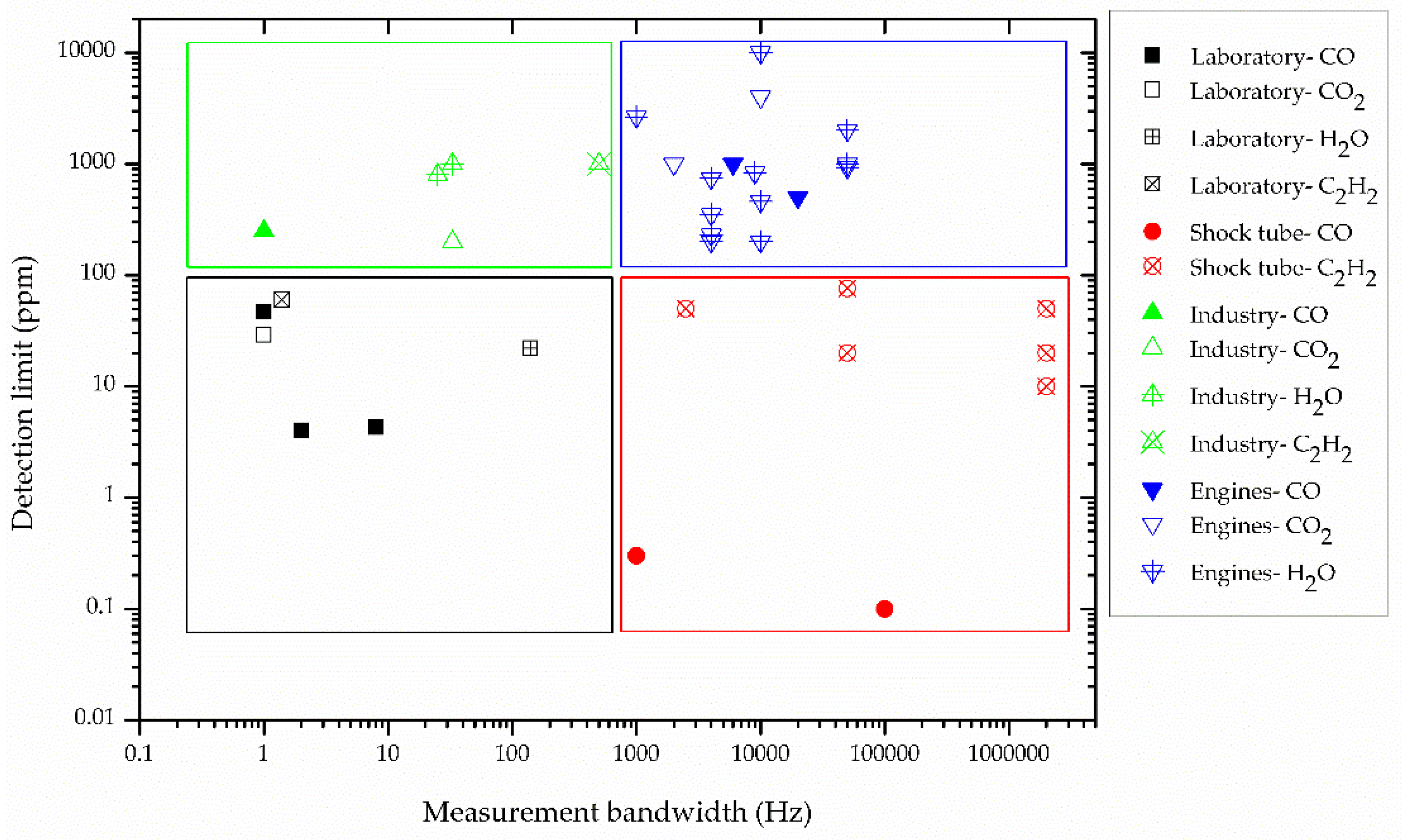


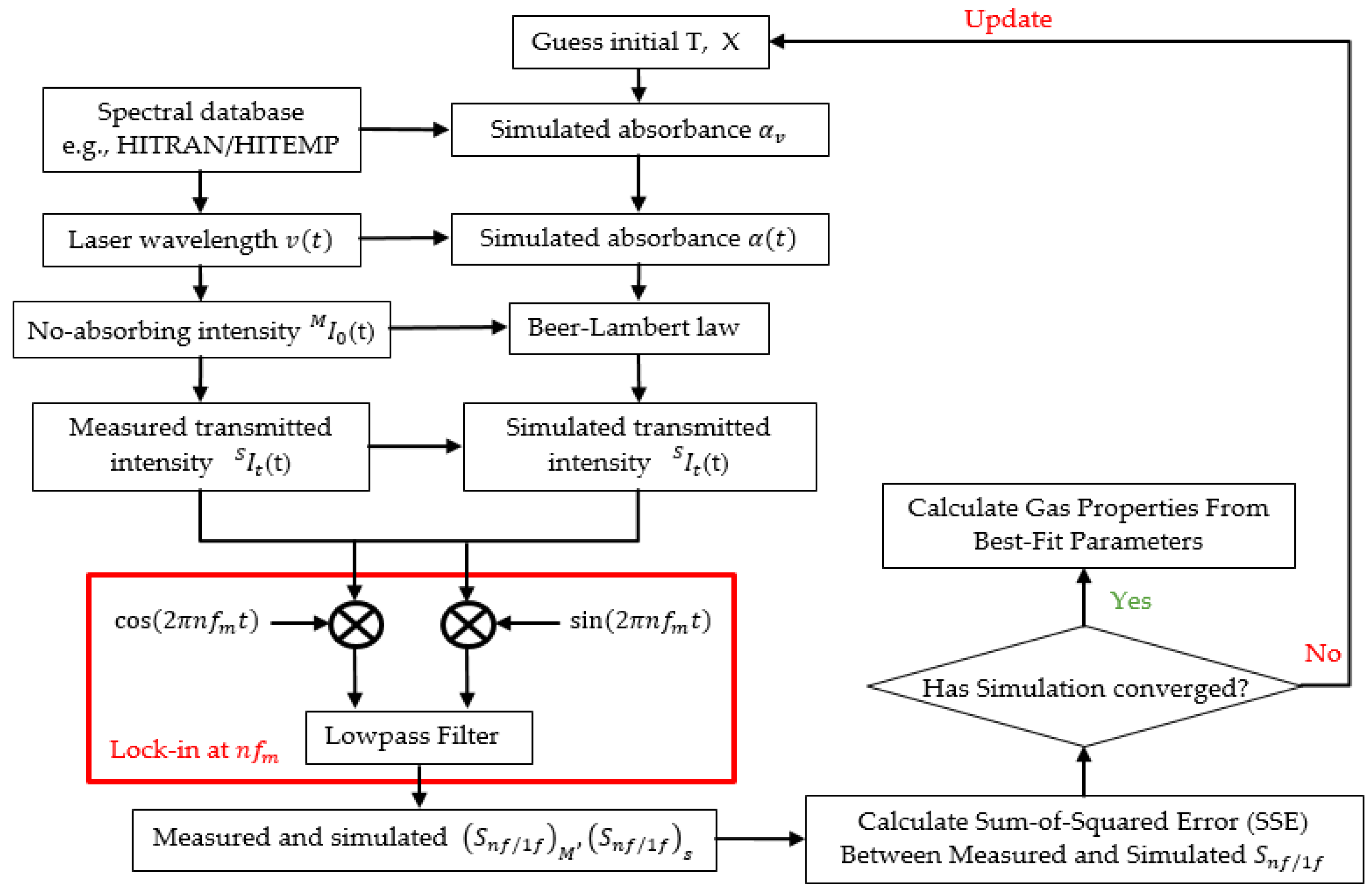
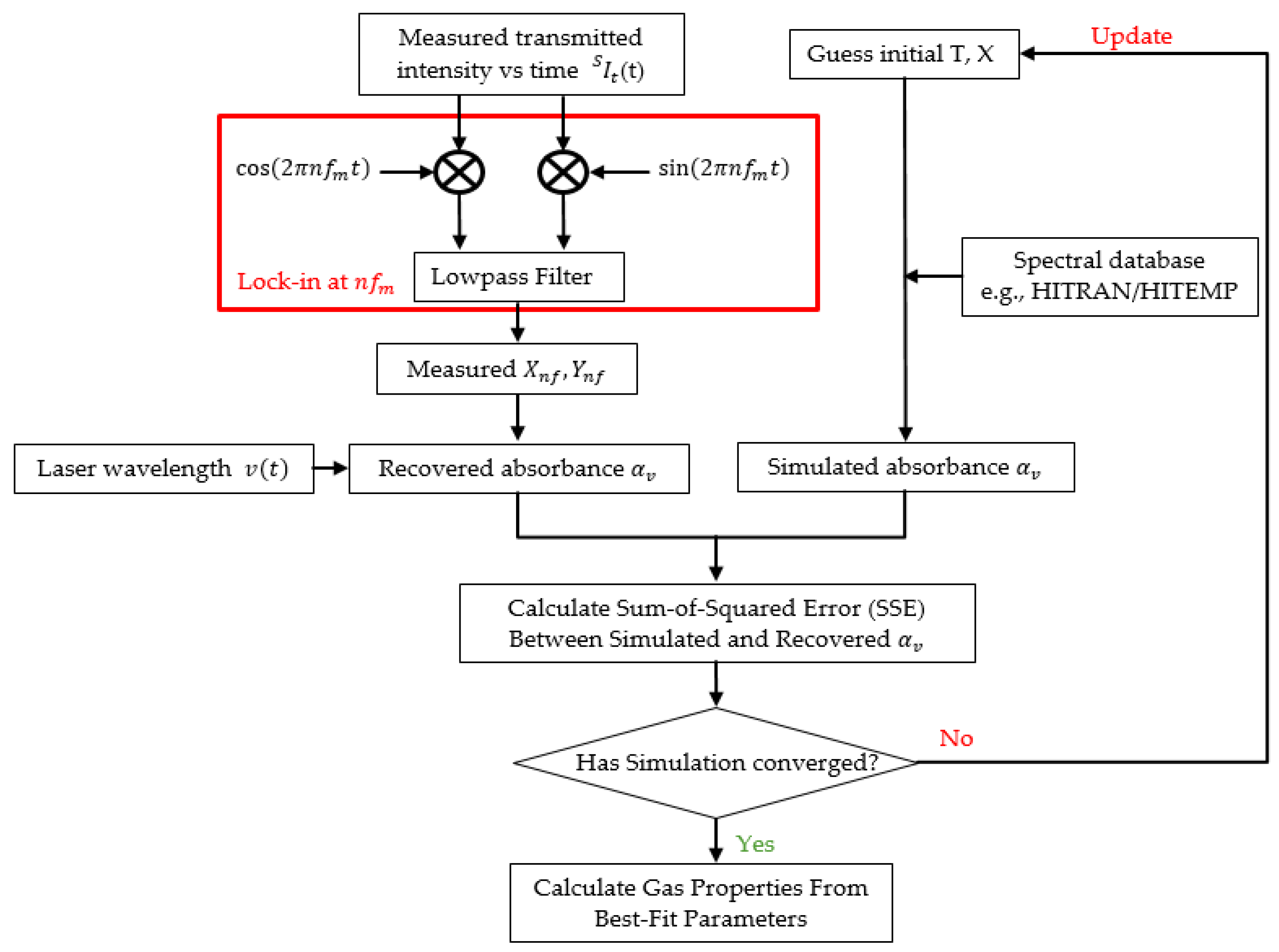
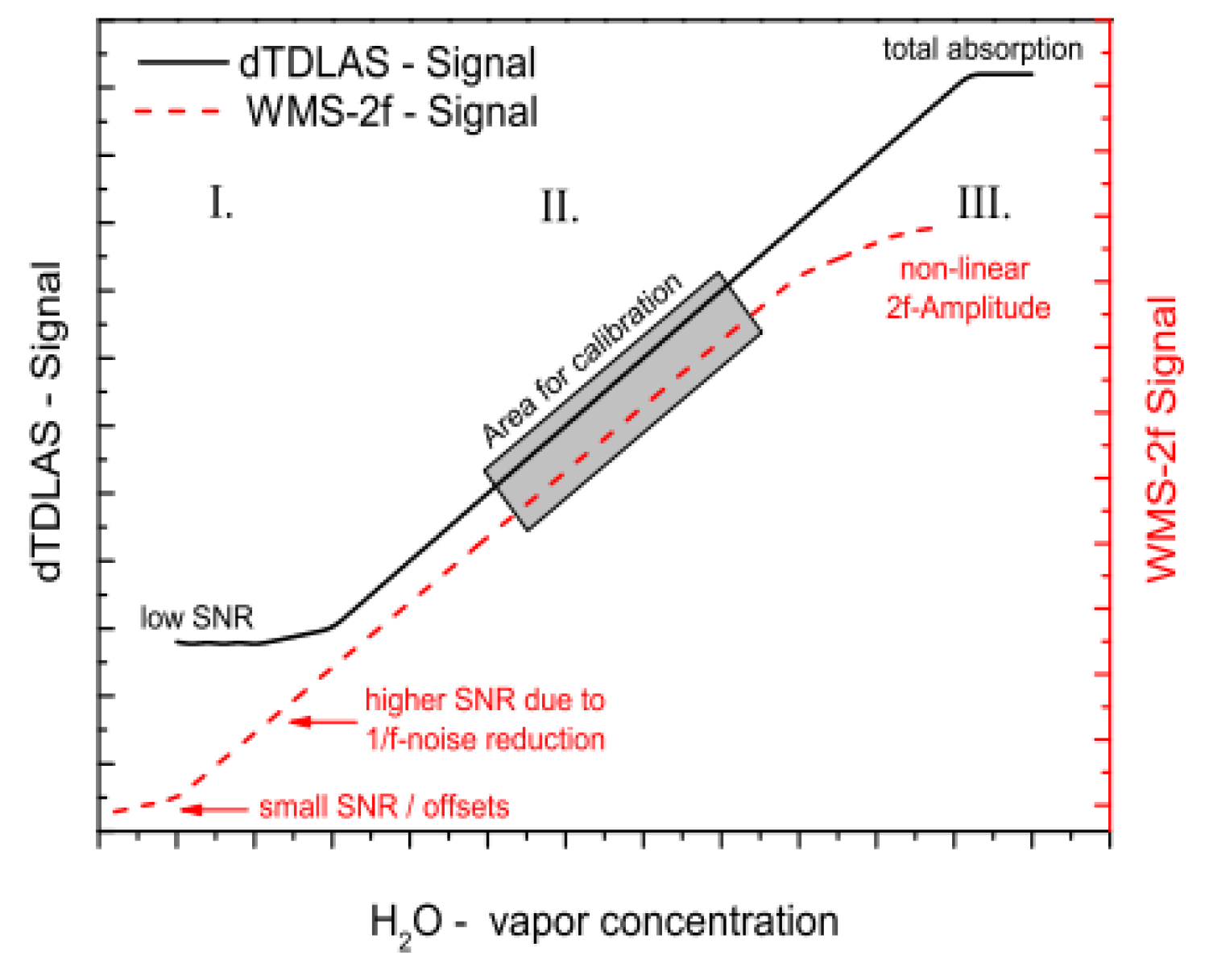
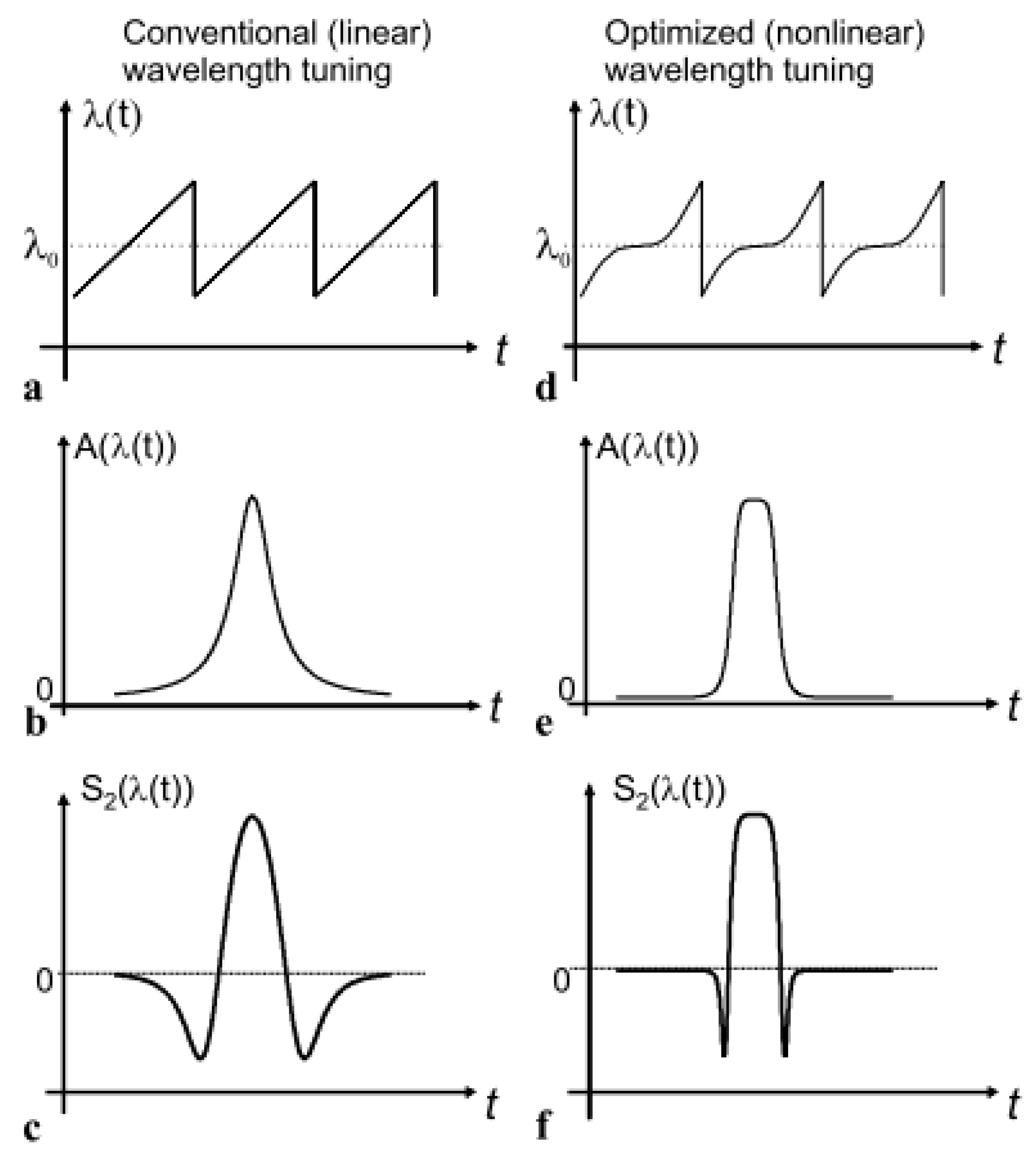
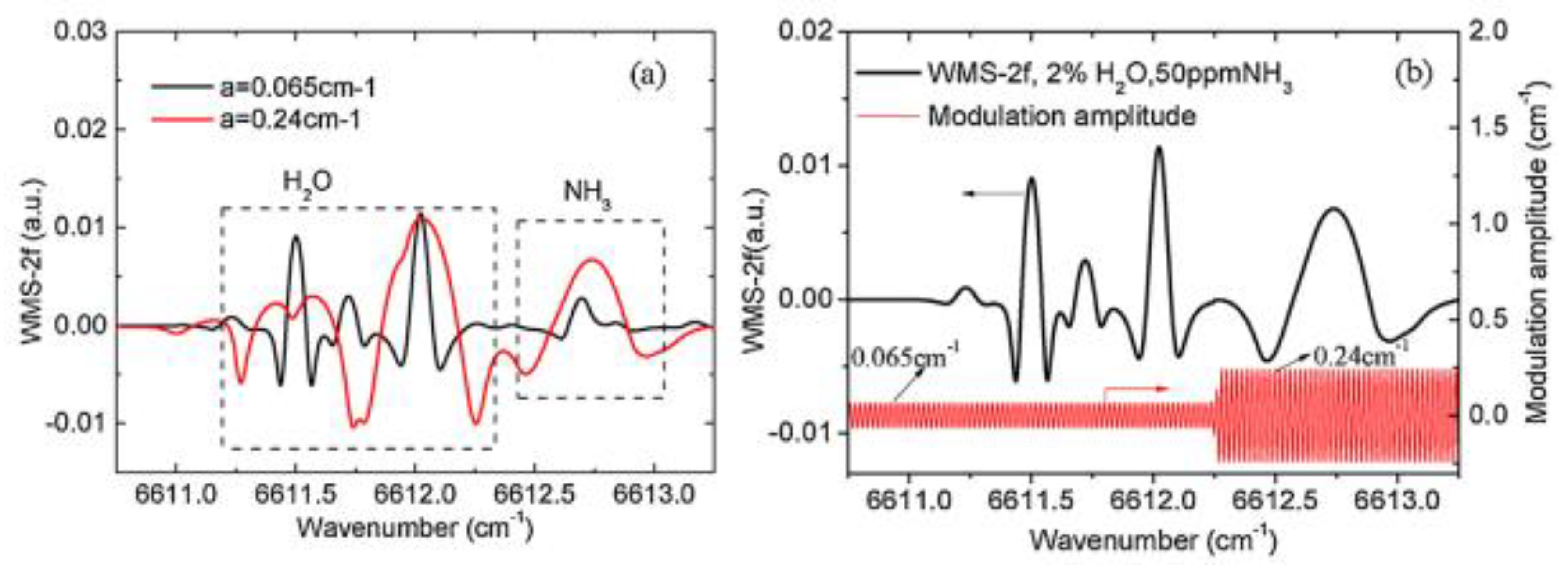
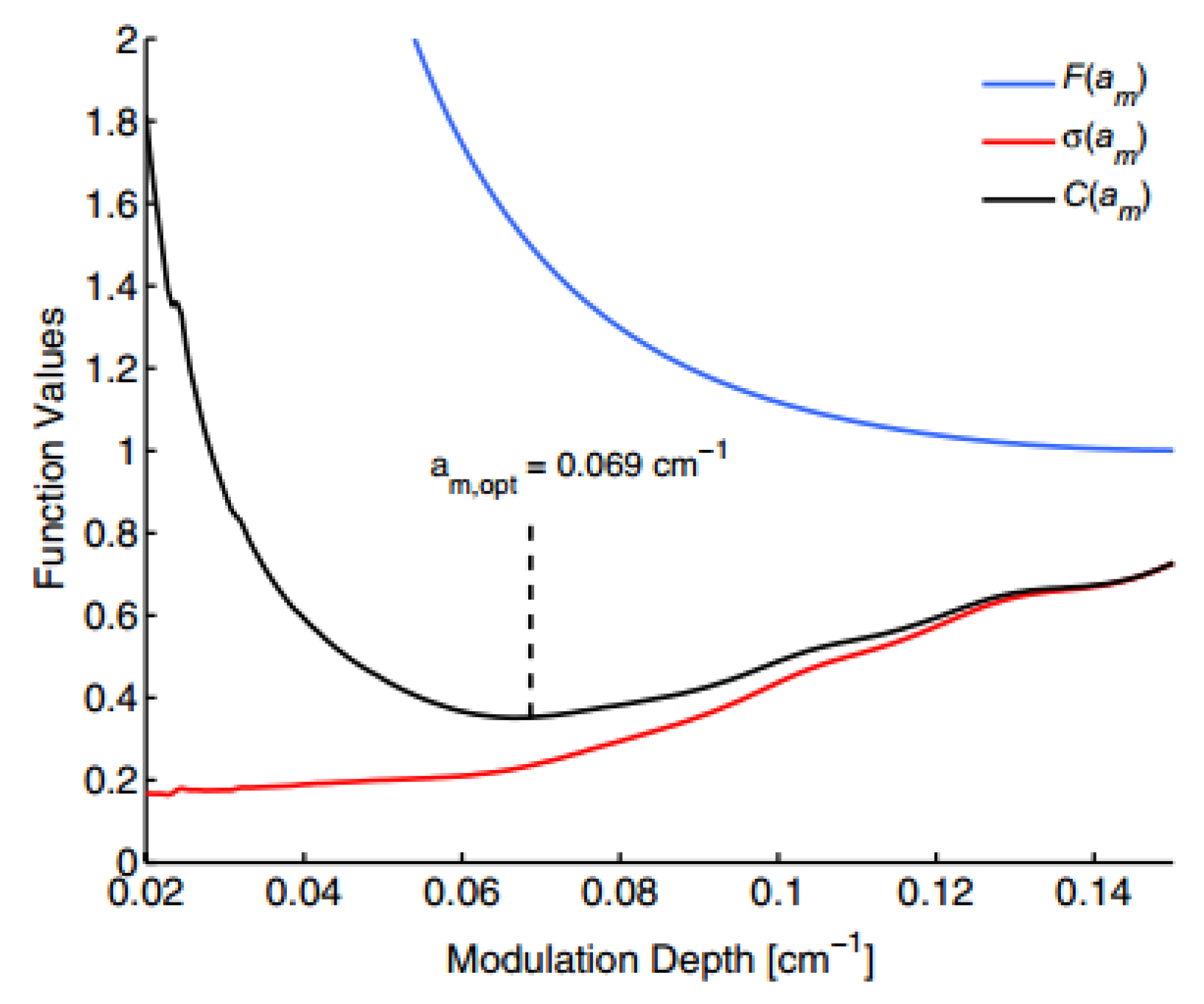



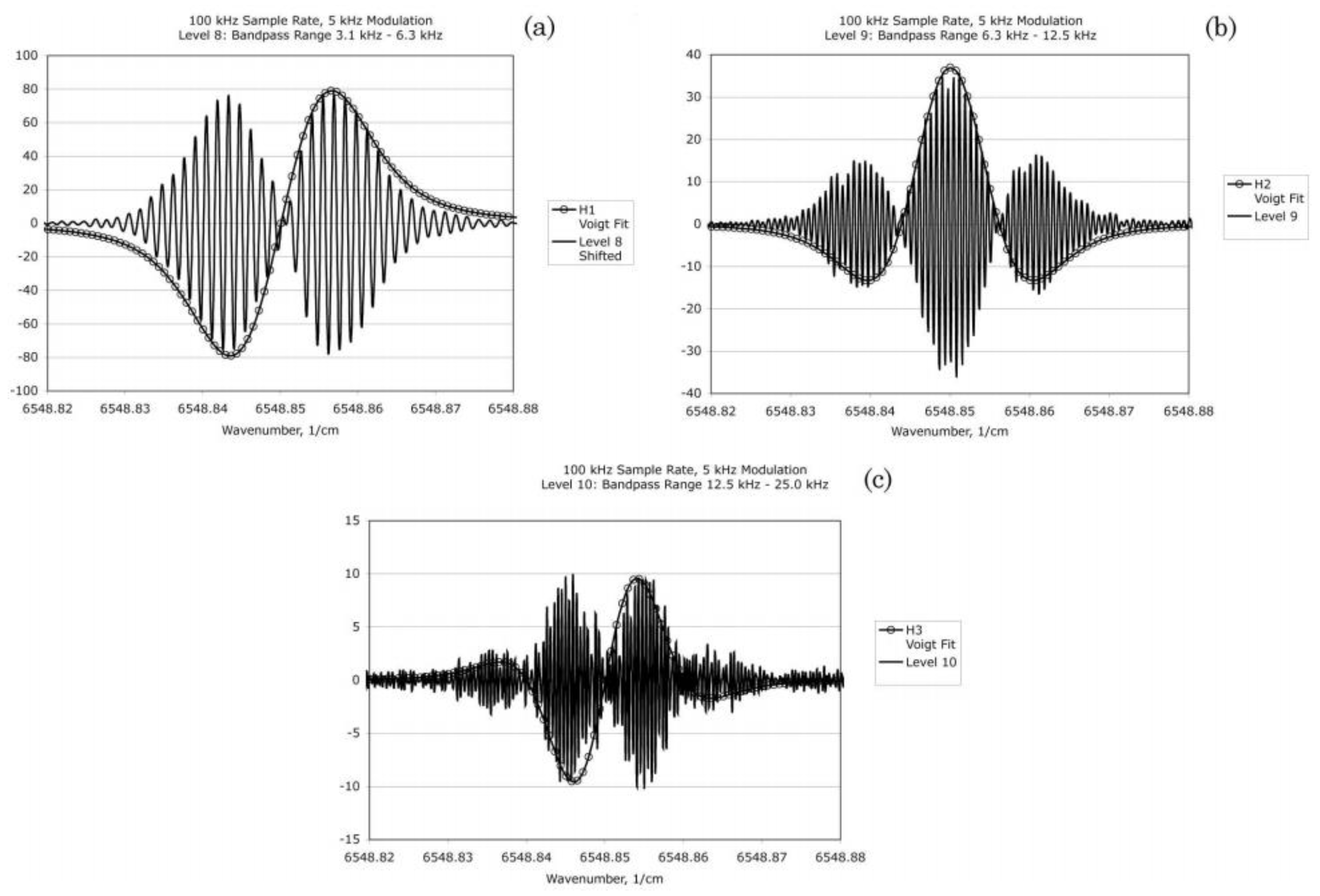
| Technique | Parameter Initialization | Parameter Predetermined | Feature/Limitation |
|---|---|---|---|
| DAS LM algorithm | no | Easy to fit multiple absorption lines | |
| DAS AI algorithm | no | Complicated to fit multiple absorption lines, a factor of 3-4 faster than the LM algorithm | |
| 2f-WMS | HITRAN/HITEMP database [47] | Calibrated on the basis of database, hard to calculate absolute T | |
| Calibration-free WMS-2f/1f with fixed-wavelength laser characterization | HITRAN/HITEMP database | Wavelength-dependent laser characteristics may lead to measurement errors | |
| Calibration-free WMS-2f/1f with scanned-wavelength laser characterization | HITRAN/HITEMP database | Non-linear laser intensity variation along measurement beam path difficult to quantify | |
| Recovery of DAS lineshapes | Higher-order harmonics come with low SNR | ||
| DAS-calibrated WMS | no | P, T | Direct, on-the-fly calibration, increased precision and SNR for trace gas detection |
| Type of noise | Cause | Feature | Frequency Range |
|---|---|---|---|
| Laser excess noise | Intensity fluctuation | Frequency dependent | 1–10 kHz |
| Detector thermal noise | Thermal agitation of the charge carriers | Frequency independent | 0.1–140 kHz |
| Detector shot noise | Discrete nature of electric charge | Frequency independent | 0.1–140 kHz |
| Detector excess noise | Intensity fluctuation | Frequency dependent | 1–10 kHz |
| Strategy | Solutions | Feature |
|---|---|---|
| Optical design | Wedged or AR-coated windows; | Difficult to minimize etalon in complex optical systems |
| Optical isolators; | ||
| Etalon immune distance | ||
| Mechanical modulation | Dithering or rotating of mirrors; | Increased system complexity; Limited detection bandwidth |
| Brewster-plate spoiler | ||
| Balanced detection schemes | Split laser beam into the sample beam and reference beam | Difficult to replicate all optical effects in reference path |
| WMS | Modulation index optimization; | SNR sacrificed |
| Use of higher harmonics | ||
| Digital filtering technique | Wavelet transform; Kalman filtering; EMD | Increasing computation cost; Parameters need to be set carefully |
| Scanning Amplitude | Scanning Frequency | Modulation Depth | Modulation Frequency | Time Constant | |
|---|---|---|---|---|---|
| Maximum 2f | - 1 | ↓ 3 | ↑↓ | ↑↓ | ↓ |
| SNR | - | ↑ or ↓ | ↑↓ | ↓ | - |
| Peak width | ↑ 2 | ↑ | - | ↓ | - |
| PHR | ↑ | ↓ | - | ↑ or -- 4 | - |
© 2019 by the authors. Licensee MDPI, Basel, Switzerland. This article is an open access article distributed under the terms and conditions of the Creative Commons Attribution (CC BY) license (http://creativecommons.org/licenses/by/4.0/).
Share and Cite
Wang, Z.; Fu, P.; Chao, X. Laser Absorption Sensing Systems: Challenges, Modeling, and Design Optimization. Appl. Sci. 2019, 9, 2723. https://doi.org/10.3390/app9132723
Wang Z, Fu P, Chao X. Laser Absorption Sensing Systems: Challenges, Modeling, and Design Optimization. Applied Sciences. 2019; 9(13):2723. https://doi.org/10.3390/app9132723
Chicago/Turabian StyleWang, Zhenhai, Pengfei Fu, and Xing Chao. 2019. "Laser Absorption Sensing Systems: Challenges, Modeling, and Design Optimization" Applied Sciences 9, no. 13: 2723. https://doi.org/10.3390/app9132723
APA StyleWang, Z., Fu, P., & Chao, X. (2019). Laser Absorption Sensing Systems: Challenges, Modeling, and Design Optimization. Applied Sciences, 9(13), 2723. https://doi.org/10.3390/app9132723





